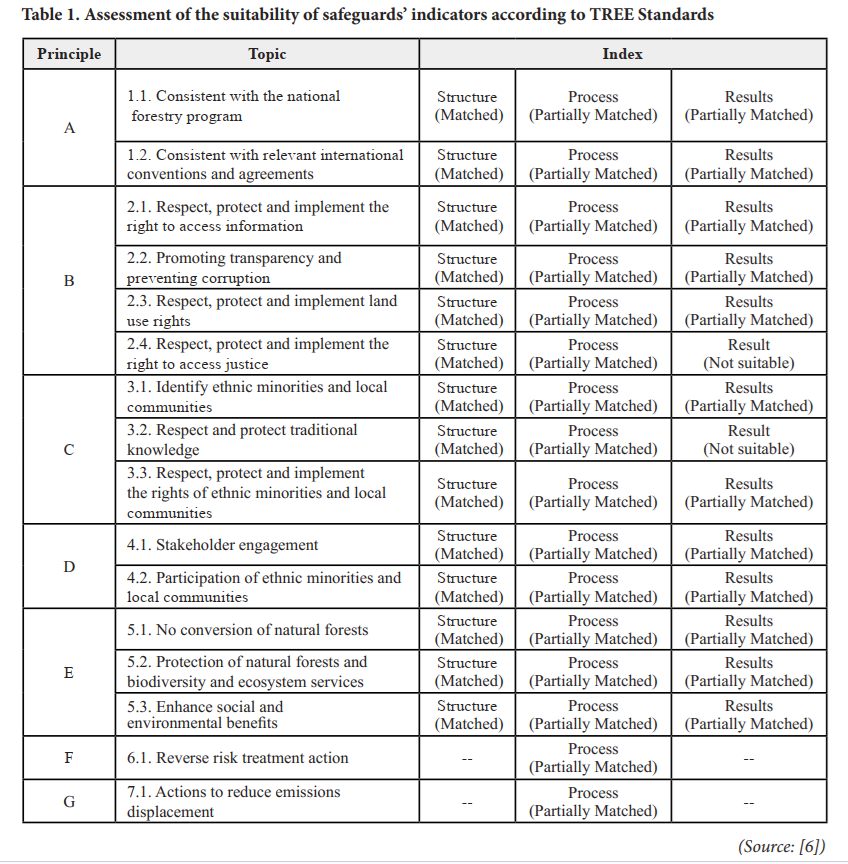

26/07/2025
1. INTRODUCTION
Reducing greenhouse-gas (GHG) emissions by limiting forest loss and degradation, conserving and enhancing carbon stocks, and managing forest resources sustainably (REDD+) was established under the United Nations Framework Convention on Climate Change (UNFCCC) as an international financial mechanism that provides results-based payments to developing countries for successfully implementing REDD+ actions. In addition to climatechange mitigation and carbon-related benefits, not only REDD+ can deliver a range of non-carbon (co-benefit) outcomes; butit also entails potential environmental and social risks. Recognizing these risks, UNFCCC Parties adopted set of seven REDD+ safeguards principles at COP 16, commonly called the “Cancun safeguards.” The Cancun Agreement requests countries implementing REDD+ to “address” and “compliance” these seven safeguards, which cover governance, emission-reduction risks, social and environmental benefits.
Vietnam is recognized as a pioneer country in REDD+, and has prepared for REDD+ implementation by issuing the National REDD+ Program, developing the National Forest Monitoring System (NFMS), Forest Reference Emission Levels/Forest Reference Levels (FREL/FRL), and developing and operating an online Safeguard Information System (SIS). Therefore, Vietnam is eligible to receive payments based on REDD+ results. Developing a Safeguard Information System (SIS) is one of the three important safeguard requirements in REDD+ of the UNFCCC. SIS is a national-level system that provides information on "review" and "compliance" with the Cancun Safeguard Principles during REDD+ implementation in Vietnam. Information on "review" of the Safeguard Principles includes descriptive information on relevant policies, laws and regulations. Information on "compliance" with the safeguards principles includes descriptive information and data on the actual implementation of policies, laws and regulations and results related to the implementation of REDD+. In order to further improve the SIS system and meet the requirements of REDD+ standards, this article assesses the current status of available information and data, identifies gaps and makes suggestions for maintaining and continuously updating the SIS system in the context of digital transformation to serve REDD+ results-based payment programs and projects in Vietnam, meeting the requirements of the UNFCCC.
2. CURRENT STATUS OF INFORMATION AND DATA ON REDD+ SAFETY INFORMATION SYSTEM
The process of developing the SIS for Vietnam began in late 2015, with the coordination of the Office of the National REDD+ Steering Committee, mobilizing resources in the design and operation of the SIS. In 2018, the basic information structure of the Vietnam SIS was built, many relevant information fields were collected and posted on the online system, although not all necessary information was available at that time because the National REDD+ ActionProgram (NRAP) [5] had not been widely implemented, or some safeguards’ indicators had not been fully defined.

Vietnam has a forest cover rate of nearly 42%
The Vietnam REDD+ SIS information page is built with a layout including information fields: Home page, overview, principles, library, feedback and contact on both English and Vietnamese language platforms. By design, the SIS system will collect data from different sources, including: National Forest Management Information System (FORMIS), Forest Resources Monitoring System (FRMS), REDD+ Portal, General Statistics Office (GSO), Ministry of Ethnic Minorities and Religions (CEMA), Ministry of Agriculture and Environment (MAE), databases of other ministries and sectors; REDD+ implementation reports and other sources. The main information sources currently available in the SIS include data on reports from relevant agencies and organizations; appraisal/monitoring reports from REDD+ projects/programs (such as the FCPF-ERP Program); FRMS; GSO; CEMA…) is widely publicized to meet the requirements for implementing payments based on GHG emission reduction results from REDD+ programs and projects.
Information updates on the SIS will be carried out annually or every 6 months, depending on the specific data source. In Vietnam, information and data updates on the SIS system have started in 2022 by assessing new REDD+ initiatives/programs and collecting newly updated data. From 2023, Vietnam's SIS system will continue to be updated to ensure that the structure of indicators, content and data are revised and updated in accordance with the requirements of the REDD+ Trading Platform (ART) and the REDD+ Environmental Excellence Standard (TREE), details are presented in Table 1.

Accordingly, the information and data of the SIS system mainly describe in detail the 7 principles of the Cancun safeguards with 17 topics and 121 indicators/ criteria related to the review and compliance with Vietnam's REDD+ safeguards requirements. Analysis based on 44 indicators (including 14 structural indicators, 16 process indicators and 14 outcome indicators according to the TREES standard) shows that the current structural indicators are completely consistent with the standard. The system has fully described the policies, laws and regulations related to the 7 Cancun safeguards principles. For the 16 process indicators, only 2 indicators are suitable: Respect, protect and implement the right to access information and do not convert natural forests. The remaining 14 process indicators are currently only partially suitable, due to the lack of implementation guidelines as well as the organization and coordination of implementation.
The current results indicators are mostly only partially consistent, especially the two indicators on respecting, protecting and implementing the right to access justice; Respecting and protecting traditional knowledge are not consistent with the standard requirements. The analysis results also show that currently, regarding ensuring access to justice, there are adequate policies, laws and regulations supporting access to justice; feedback mechanisms, conflict resolution, and complaints applied in REDD+. However, the results of the feedback mechanism, conflict resolution, and complaints applied to REDD+ are not currently available on the SIS system. Regarding respecting and protecting traditional knowledge, information and data are fully displayed on the SIS system such as: Policies, laws and regulations on the rights of ethnic minorities and local communities; Benefits, risks and measures to promote the rights of ethnic minorities and local communities; The results relate to the rights of ethnic minorities and local communities to land and forests and the access to forest resources of ethnic minorities and local communities. However, there is currently a lack of indicators in the system such as: the results of solutions in the National REDD+ Program to enhance benefits and reduce risks for ethnic minorities and local communities; results related to benefit sharing for ethnic minorities and local communities; results related to cultural rights and results of the feedback, conflict resolution and grievance mechanism (GRM) for REDD+.
In addition, there are many other indicators that do not have data yet such as: Funding for the national REDD+ program; results related to REDD+ benefit sharing for ethnic minorities and local communities; implementation of stakeholder participation mechanisms at the national and local levels; results of implementing solutions on natural forest and biodiversity conservation; results of identified solutions to conserve natural forests and biodiversity; number of species used in plantation forests; results of solutions to reduce the risk of emission reversal in the National REDD+ Program and results of specific solutions to reduce emission displacement.
The results of the assessment of the data connection of indicators between the SIS system and database sources related to forest resource management results such as the Forestry Management Information System (FORMIS), the Forest and Forest Land Monitoring System (FRMS), the Vietnam REDD+ information page... have been interrupted, disconnected, or switched from open access to account authorization due to the process of restructuring the apparatus and new regulations on data information sharing. This is considered a risk of the SIS system when many indicators are directly connected to other data information systems.
3. CONCLUSION AND RECOMMENDATIONS
3.1. Conclusion
The Vietnam REDD+ safeguards information system has compiled data information based on 7 REDD+safeguards principles, detailed into 17 topics, each topic requires answering questions related to REDD+ actions, information and data must demonstrate the requirements for review and compliance with safeguards principles, specific indicators will demonstrate information and data review and compliance. This system must be maintained regularly and requires updating information and data annually or every 6 months. However, the results of the assessment of the current status of information and data on the implementation of 121 safeguards indicators on the SIS system show that although the current indicators and review indicators have not been updated regularly, the information and data are quite complete.
For the group of compliance (result) indicators, there is still a lack of information and data, as some indicators require periodic assessment, and the capacity to integrate information and data from other monitoring and evaluation indicator systems is still limited. According to Vietnam’s REDD+ implementation roadmap, the country has now entered the full implementation phase, which requires the nation to comply with safeguard measures, and the information and data on the result indicators must be updated to the SIS system in both Vietnamese and English versions. To obtain information that ensures compliance with Vietnam’s REDD+ safeguard principles, especially the result indicators on the implementation of REDD+ policies and measures, it is necessary to mobilize resources and time to compile and update them from various sources.
3.2. Recommendations
Vietnam is considered a country with a high level of participation in the REDD+ financial mechanism, currently implementing the FCPF-ERP program in the North Central region and in the process of negotiating to deploy the LEAF Program in the South Central and Central Highlands regions. Forest carbon standards require increasingly high levels of payment and exchange at higher prices. For example, the FCPF program pays an average of 5 USD/ton CO2, however, the LEAF Program requires a minimum of 10 USD/ ton CO2 for the results-based payment mechanism, and if carbon credit transactions are conducted, the price may be higher due to different standards and conditions. High carbon standards come with high compliance with safeguards principles and require higher implementation resources. Currently, forest carbon pricing in Vietnam has not been fully calculated as a basis for payment and exchange of forest carbon credits. Therefore, it is recommended that is need of research and development of guidelines for forest carbon pricing according to different forest carbon standards, because each carbon standard will have different requirements for compliance with the Forest Carbon Standards, and accordingly, the costs for ensuring compliance will also be different.
Along with that, to ensure information and data requirements, it is necessary to innovate in the application of information technology, large databases, and artificial intelligence to serve the SIS system to connect database systems of indicators, review indicators and comply with safeguards principles, establish an online safeguards index update system... to improve transparency and accountability, and especially to serve forest carbon standards, or payment mechanisms based on REDD+ results.
Lê Trọng Hải
Institute of Strategy and Policy on Agriculture and Environment
(Source: The article was published on the Environment Magazine by English No. II/2025)
REFERENCES
1. Ministry of Agriculture and Rural Development (2015). Decision No. 5414/QD-BNN-TCLN dated December 25, 2015 on approving the guidelines for developing provincial action plans on reducing GHG emissions through efforts to reduce deforestation and forest degradation, sustainable forest management, conservation and enhancement of forest carbon stocks (REDD+).
2. Government of Vietnam (2018). First information briefing report on the review and compliance with the REDD+ safeguards principles (SOI 2018).
3. Department of Forestry and Forest Protection (2025). Vietnam REDD+ Safeguards Information System (SIS). https://sis.kiemlam.gov.vn/vi_VN/web/guest/home.
4.Forest Carbon Partnership Facility (2018). Project completion report: https://www.forestcarbonpartnership. org/system/files/documents/FCPF%20Readiness%20 Fund%20Country%20Completion%20Report%20-%20 Vietnam.pdf .
5. Prime Minister (2017). Decision No. 419/QD-TTg dated April 5, 2017 of the Prime Minister approving the National Program on GHG Emission Reductionthrough reducing deforestation and forest degradation; conserving, enhancing carbon stocks and sustainably managing forest resources by 2030.
6. UNEP/WCMC and IPSARD (2023). Draft ARTTREES Registration Dossier Part 7: safeguards Principles. Consultation workshop on implementing the LEAF initiative and TREES registration dossier organized by the Forestry Department on August 11, 2023 in Hanoi.
7. UNFCCC (2010). Decision 1/CP.16 Cancun Agreements. 8. UNFCCC (2015). Decision 17/CP.21: Further guidance on ensuring transparency, consistency, comprehensiveness and effectiveness when informing on how all the safeguards referred to in decision 1/CP.16, appendix I, are being addressed and acknowledged.